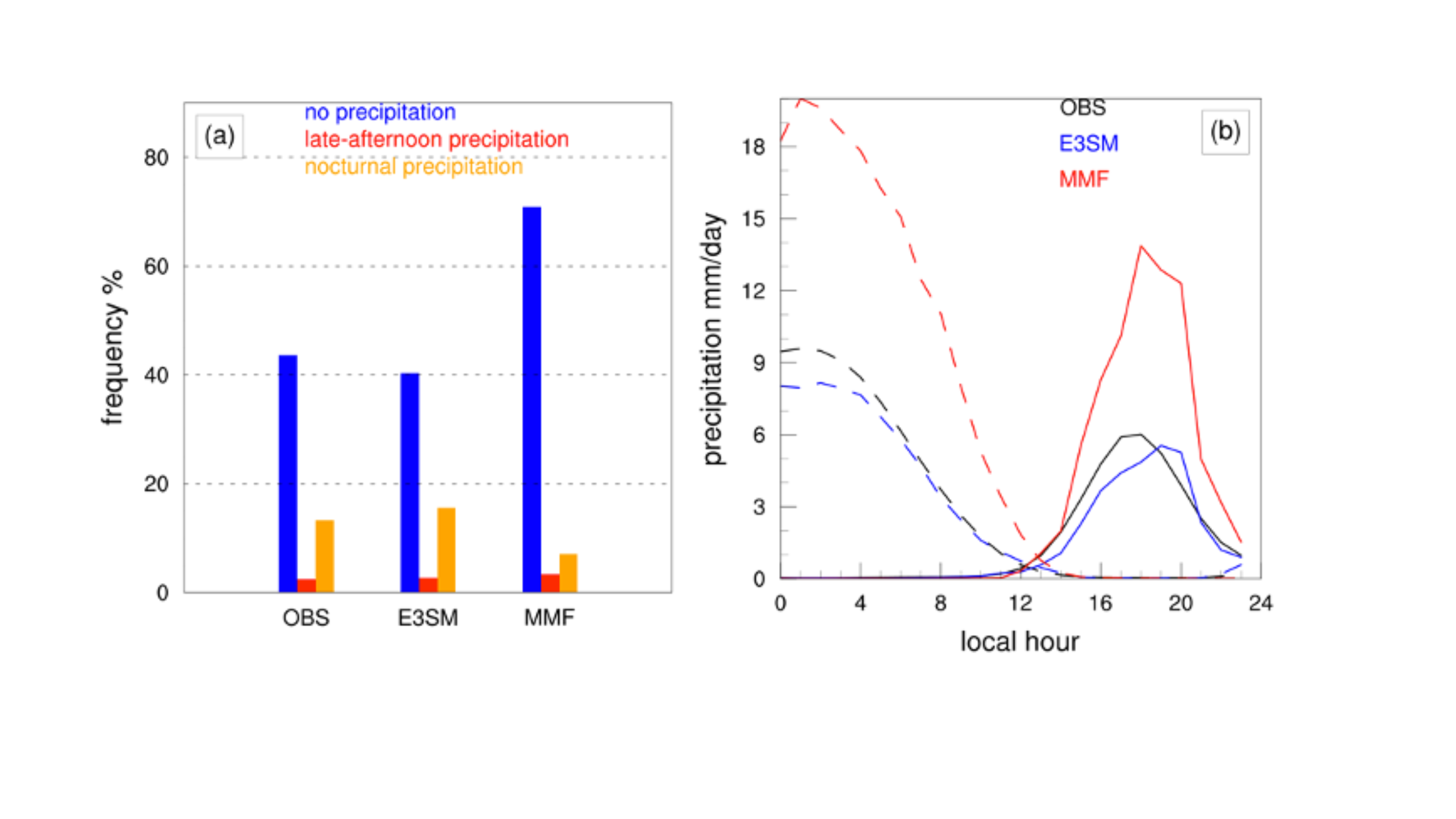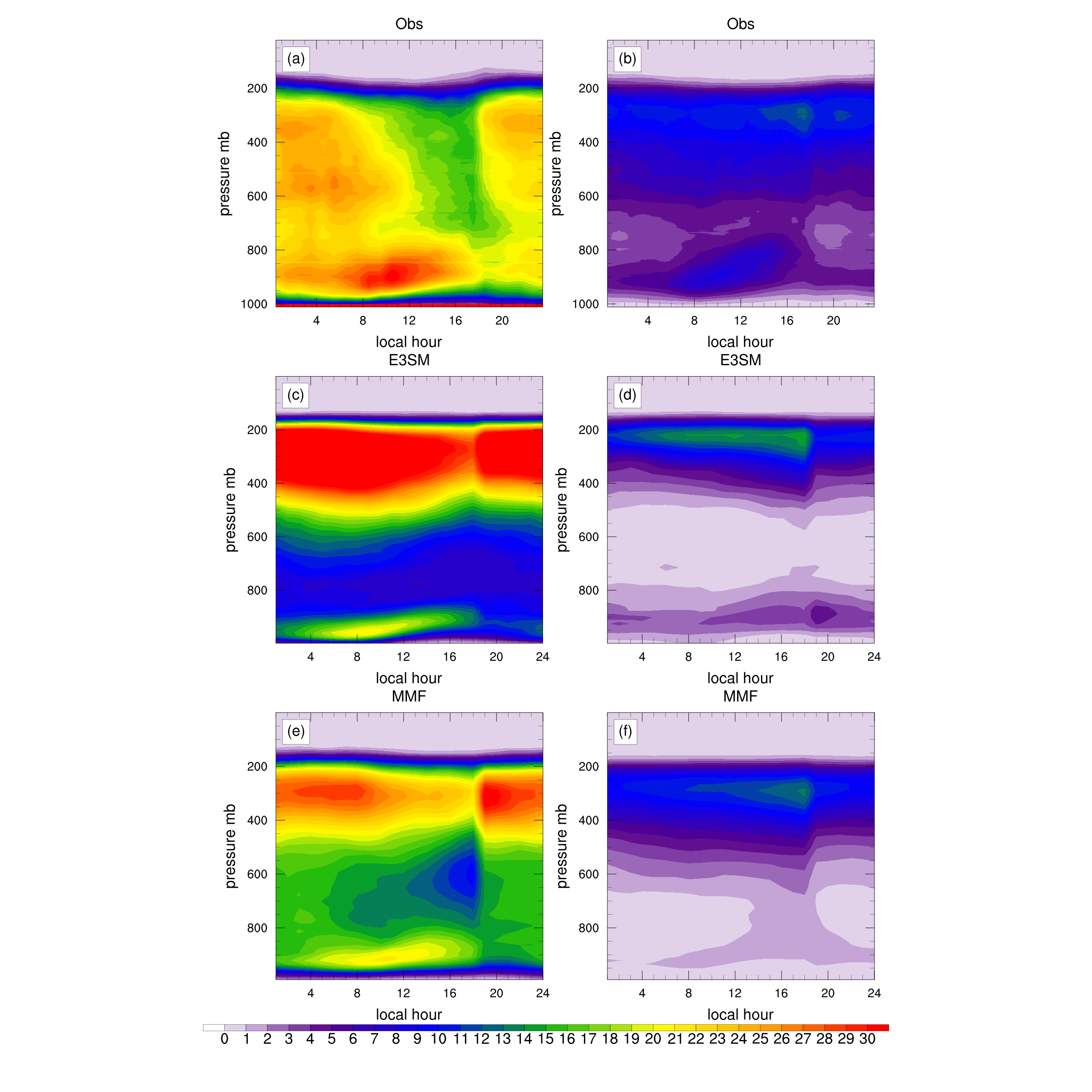Assessment of warm and dry bias over ARM SGP site in E3SMv2 and E3SM-MMF
Submitter
Xie, Shaocheng — Lawrence Livermore National Laboratory
Area of Research
General Circulation and Single Column Models/Parameterizations
Journal Reference
Lee J, C Tao, W Hannah, S Xie, and D Bader. 2023. "Assessment of warm and dry bias over ARM SGP site in E3SMv2 and E3SM-MMF." Journal of the Atmospheric Sciences, 80(10), 10.1175/JAS-D-23-0062.1.
Science

Figure 2. (a) frequency of dry days, days with late afternoon precipitation maximum, and days with nighttime precipitation maximum for observation, E3SM and E3SM-MMF. In (b), diurnal cycle of precipitation is composited for each convective regime. Dashed lines represent the diurnal cycle of precipitation for days with nocturnal precipitation, while solid lines represent the diurnal cycle of precipitation for days with late-afternoon precipitation. In (b) observation is marked in black, E3SM simulation result is shown in blue, and E3SM-MMF is shown in red. From journal.

Figure 1. JJA diurnal cycles of cloud fraction (%) composited for (left column) precipitating and (right column) non-precipitating days. Precipitating days are defined as the days when the daily maximum exceeds 0.1mm/day. Top row (a, b) is from ARMBE observation at ARM SGP central facility (CF), 2nd row (c, d) is from E3SM, and 3rd row (e, f) is from E3SM-MMF simulation. Y axis shows vertical level in pressure (mb). X axis shows hour in local time. From journal.
Many climate models exhibit a dry and warm bias over the central U.S. during the summer months. Understanding the causes of this bias is important to shine a light on this common model error and reduce the uncertainty in future projections. In this study, we diagnosed the summertime warm and dry bias at the U.S. Department of Energy (DOE) Atmospheric Radiation Measurement user facility's Southern Great Plains observatory in version 2 of DOE's global climate model E3SM (E3SMv2) and multiscale modeling framework version of E3SMv2 (E3SM-MMF).
Impact
Our results confirm that the deficit of precipitation leads to the excessive warming near surface. However, the reason for the underestimate of precipitation is different in both configurations of E3SMv2. In E3SMv2 the underestimation of precipitation is due to precipitating events that are “too frequent, too weak” while in E3SM-MMF precipitation events are “too rare, too intense” relative to the observations.
Summary
In this study, we use E3SMv2 and E3SM-MMF to assess how parameterized and resolved convection affect temperature and precipitation biases over the Southern Great Plains site of the ARM facility. Both configurations overestimate near-surface temperature and underestimate precipitation at the SGP site. The bias is associated with a lack of low-level clouds during days without precipitation and too much incoming solar radiation causing the surface to warm. Low-level cloud fraction in E3SM-MMF during the non-precipitating days is lower in comparison to E3SMv2 and observation, consistent with the larger warm bias. We also find that the underestimated precipitation can be characterized as “too frequent, too weak” in E3SMv2 and “too rare, too intense” in E3SM-MMF. These deficiencies conspire to sustain the warm and dry bias over the central U.S.
Keep up with the Atmospheric Observer
Updates on ARM news, events, and opportunities delivered to your inbox
ARM User Profile
ARM welcomes users from all institutions and nations. A free ARM user account is needed to access ARM data.


















